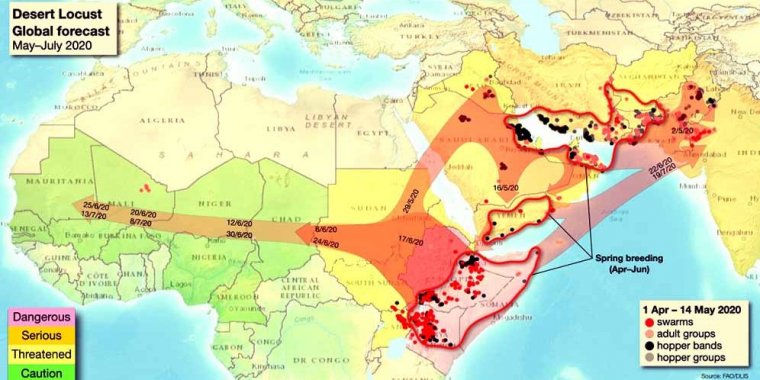| News / Science News |
Famine risk for millions in second locust wave
A second wave of desert locusts in Africa and Asia is threatening famine for millions as critical resources are directed towards the COVID-19 crisis, scientists warn.

FAO desert locust global forecast May-July 2020. Photo: SciDev.Net
Desert locusts are already swarming in East Africa and breeding in Iran and Pakistan, as well as Yemen, the Food and Agriculture Organization (FAO) says.
The outbreak, which has been raging since last year, has so far placed around 20 million people at acute food insecurity in Ethiopia, Kenya, Somalia, South Sudan, Uganda and Tanzania.
Swarms have “been damaging crops and pastures and crippling communities in the Greater Horn of Africa, Arabian Peninsula and Southwest Asia” since October, explained World Resources Institute climate programme research analyst Tina Huang.
However, without action the locust population “could grow 400 times larger by June 2020 and spread to new areas, disrupting food supply, upending livelihoods and requiring substantial resources to address”.
The level of threat in West Africa could also change significantly in the next few weeks based on rainfall, winds and the locust situation in Arabia and East Africa.
Swarms risk migrating to summer breeding areas in India and Pakistan, as well as Sudan and parts of West Africa, including the Sahel and Chad.
The World Bank estimates that, in Africa alone, more than 90 million hectares of cropland and pasture are at risk from the second wave, with damages and losses reaching US$9 billion.
In East Africa, pesticide shipments to the worst-affected areas have already been delayed due to the COVID-19 pandemic.
A second wave of locusts could exacerbate already-disrupted global supply chains.
This would have untold effects on food security … leaving smallholders even more vulnerable than before and jeopardising the economic outlook for recovery in the affected countries.
When affected households and families struggle to meet basic needs such as food and shelter, nutrition, healthcare, and education may be neglected, hindering long-term health and development, especially of children.
Studies of past locust plagues found a notable decrease in school enrolment in affected areas as well as evidence of stunting in infants and children. (SciDev.Net)
YOU MAY ALSO LIKE





